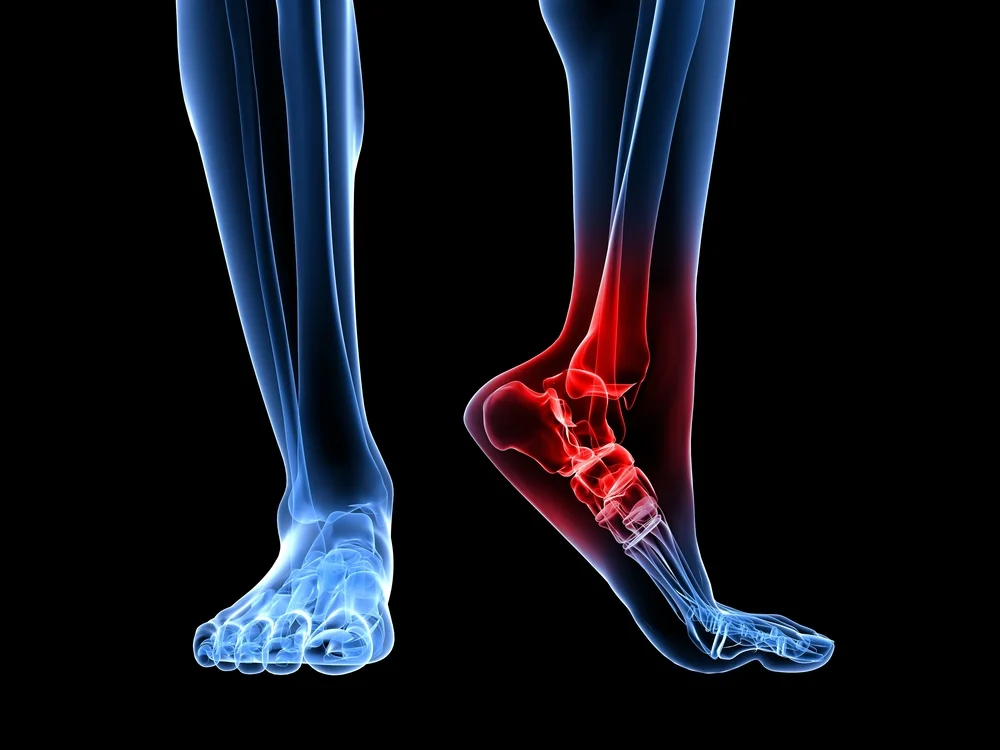Our Podiatrist In Scarborough, ME Can Help With Your Heel Pain
HEEL PAIN (PLANTAR FASCIITIS)
Plantar fasciitis is the term commonly used to refer to heel and arch pain on the bottom of the foot. More specifically, plantar fasciitis is an inflammation of the connective tissue, called plantar fascia, that stretches from the base of the toes, across the arch of the foot where it attaches into the heel bone. Overpronation is the most common cause of plantar fasciitis. As the foot rolls inward excessively when walking, it flattens the foot, lengthens the arch, and puts added tension on the plantar fascia. Over time, this causes inflammation. Pain is generally worse in the morning when first getting out of bed or when sitting for prolonged periods.
Factors that may increase your risk of developing plantar fasciitis include:
Age. Plantar fasciitis is most common between the ages of 40 and 60.
Sex. Women are more likely than are men to develop plantar fasciitis.
Certain types of exercise. Activities that place a lot of stress on your heel and attached tissue — such as long-distance running, ballet dancing and dance aerobics such as Zumba— can contribute to an earlier onset of plantar fasciitis. (See our Runner's Guide to Heel Pain)
Faulty foot mechanics. Being flat-footed, having a high arch or even having an abnormal pattern of walking can adversely affect the way weight is distributed when you're standing and put added stress on the plantar fascia. A tight heel cord, Achilles tendon and decreased motion of the big toe joint also contribute to heel pain.
Obesity. Excess pounds put extra stress on your plantar fascia.
Occupations that keep you on your feet. Factory workers, teachers, retail workers and others who spend most of their work hours walking or standing on hard surfaces like concrete can damage their plantar fascia.
Improper shoes. Avoid loose, thin-soled shoes, as well as shoes without enough arch support or flexible padding to absorb shock. If you regularly wear high heels over 2 inches your Achilles tendon — which is attached to your heel — can contract and shorten, causing strain on the tissue around your heel. If your "go to shoe" is over a year old, chances are your foot pain would be lessened with a new pair of new shoes. Wearing the wrong shoe for your foot type can also contribute to heel pain.
Diagnosis
Diagnosis can be made by x-ray to evaluate for spurs and diagnostic ultrasound to evaluate the integrity of the plantar fascia and measure the thickness. Recalcitrant cases of heel pain may require further diagnostic testing such as blood work to rule out a systemic arthritis, MRI to evaluate for a plantar fascial tear or bone scan to rule out a stress fracture of the heel bone.
Treatment
Plantar fasciitis is often successfully treated with conservative measures, such as the use of anti-inflammatory medications, topical analgesics, cold packs, stretching exercises, equinus brace, ultrasound guided steroid injections, taping, orthotic devices, and physical therapy. Note: Please consult your physician before taking any medications. Other treatments include immobilization in a cam walker, amniotic membrane injection, and radial pulse therapy, aka shockwave therapy. Roughly 95% of patients get better with conservative measures.
Not all heel pain is plantar fasciitis. Other causes of heel pain include:
tarsal tunnel syndrome
calcaneal spur
fat pad atrophy
calcaneal stress fracture
bursitis
plantar fascial tear or rupture
arthritis such as Reiter's syndrome, ankylosing spondylitis
Achilles tendonitis
Dr. Kurlanski recommends and carries Footstep for heel pain.
Sometimes OTC inserts are not enough to treat the heel pain and Custom Orthotics are necessary. A custom orthotic will have a deep heel cup, full arch contact and forefoot correction if needed. Cushioning to the device may be added especially if the patient is standing for several hours during the day. We are proud to offer same day custom molded orthotics.
What are some stretches to help with heel pain?
Stretching is one of the best ways to relieve heel pain. Try to do a little exercise to loosen and relax your calves and Achilles tendons when your heels hurt. The towel stretch works well. Sit with your feet in front of you, then loop a towel around the ball of your foot. Pull back on the ends of the towel until you feel the stretch behind your heel and in the calf. You could also try the wall stretch. Stand facing a wall with the painful foot 6 inches or more behind the other. Put your hands on the wall and lunge forward, keeping your back and hips straight. Lock your back knee and keep your heels planted firmly on the ground. Then repeat with your back knee bent.
There are plenty of stretches you could try, like the plantar stretch, the heel-to-wall press, and general exercises like picking up marbles with your toes. If you’re struggling with pain in your heels and would like help with the discomfort or you’d like to learn to stretch properly, contact Dr. Michele Kurlanski at Lighthouse Foot and Ankle Center.
An alternative to stretching is an Equinus Brace which is worn one hour per day to stretch the Achilles tendon and the plantar fascia.
RUNNER'S GUIDE TO HEEL PAIN
Plantar Fasciitis Signs and Symptoms
Plantar fasciitis is a very common foot complaint due to repetitive stress to the plantar fascia. It affects about 8% of runners. You may experience heel pain when you get out of bed in the morning or after sitting for long periods. The pain usually eases up after a few step and may not hurt during the course of the day. You may even go for a run later in the day, but the next morning when you get out of bed, the pain is worse. You may notice that your calves are tight. Over the next few weeks the pain can increase and become more frequent.
Causes
In runners heel pain may be due to doing too much too soon, not stretching enough, running on hard surfaces, running in old worn out sneakers or over pronating.
Home Treatment
There are several things you can do at home.
Rest. Try cutting your running mileage in half then gradually increase the distance over the next few weeks. Running through pain is a bad idea. If the pain does not resolve then you may need to take a few weeks off.
Ice. Apply an ice pack or a bag of frozen veggies to your heel for 10-15 minutes.
Stretch, Stretch, Stretch. Roll your foot around and spell the letters of the alphabet before you get out bed. Stretch your arch by grabbing your toes and pulling back toward your shin. Stretch your Achilles tendon with your knee bent and straight for 3-4 reps several times a day. Warm up and stretch before and after a run. Wall stretches also work well. You cannot over stretch.
Anti-inflammatories. Motrin or Aleve can help reduce the inflammation. Massage. Rolling your heel and arch over a golf ball for 10-15 minutes per day can also be helpful.
New shoes. If your shoes have more than 600 running miles on them, it may be time for a new pair. You may also may in the wrong shoes for your foot type causing you to overly pronate. Alternate exercises. Swimming and biking are good aerobic excises that do not stress the plantar fascia.
When to Seek Professional Help
If you have had heel pain for over a month and have tried our recommendations, it is a good idea to make an appointment. The longer your have heel pain, the longer it takes to resolve. Also, if you find yourself taking an anti-inflammatory daily for 3 weeks or more, it is worth a call. It may mean that the pain has become more chronic than acute. Taking an NSAID for a long period increases the risk of a stomach ulcer or heart burn. If you have diagnosed yourself with plantar fasciitis and it is not getting better, your heel pain may be due to other reasons, like tarsal tunnel, stress fracture or bursitis.
Treatments Your Podiatrist May Recommend or Provide
Taping - A Low dye strapping or Kinesio tape. Taping helps takes stress off the plantar fascia and support the arch.
OTC orthotitcs such as Footsteps of Nolaro inserts that are semirigid with a deep heel cup.
Cortisone Injection - Best when the patient has specific point tenderness and under ultrasound guidance to pin point the area of inflammation. It is recommended that you not run for 2 weeks after the injection.
Custom Molded Orthotics - Semirigid full length orthotics, made of polypropylene if OTC orthotics are not effective. These are prescribed and fabricated after the acute phase of pain has resolved to prevent the injury for recurring.
Physical therapy referral for stretching, range of motion exercises and friction massage to decrease and soften scar tissue that results from chronic plantar fasciitis.
Stretching exercises for the Achilles tendon and Plantar Fascial Specific stretches. Alternatively an Equinus brace may be dispensed to provide passive stretch of the Achilles tendon and the palntar fascia. The brace is worn for one hour per day.
Radial Pulse Therapy - Shockwave Therapy. Three to four 5-minute treatments. Patients are not sidelined and may run during this treatment as compared to a steroid injection.
Rest - Unfortunately you may need to stop running. Trying to run when the pain has not totally resolved may make it worse. Cross training such as swimming or biking may be a good alternative to running.
It usually takes a combination of several treatment modalities to resolve your heel pain. There is no instant cure. Plantar fasciitis takes patience and perseverance to resolve.
But doc, I need to run...Plantar fasciitis can be very frustrating but it takes time to heal. The longer you run on a painful heel the longer it will take to get better. Chronic plantar fasciitis is more challenging to treat than acute, but take heart, 90-95% of patients get better with conservative care.



